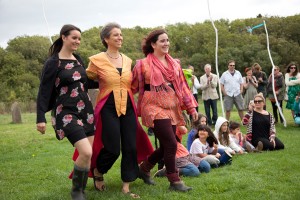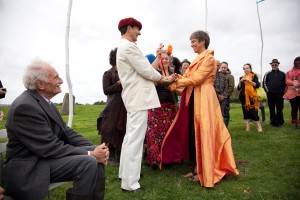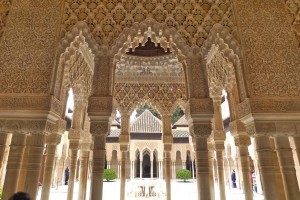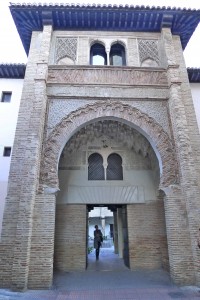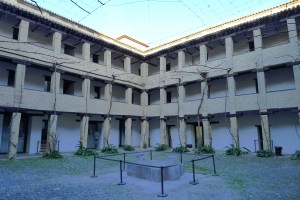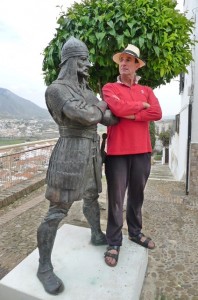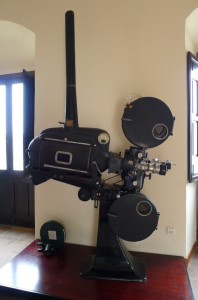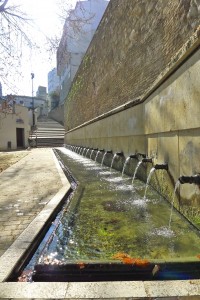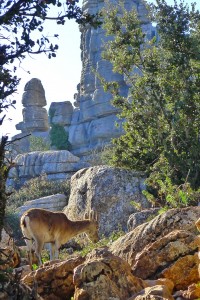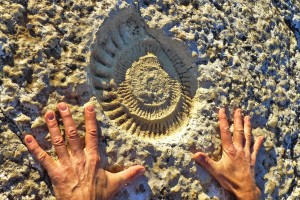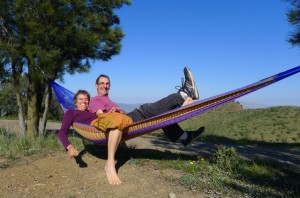The Purpose of the Journey
Yesterday evening, after a lovely outdoor Milonga by the riverside in Granada, a group of people went to a café for a drink and some Tapas. I got talking to a German couple and they asked me about the purpose of our journey. The purpose of this journey, I tell them, is two-fold… celebrating the closing of one chapter and the opening of another.
I tell them how, about 20 years ago, when I was pregnant with my second daughter, I made a deal with myself to go on a long journey once my children left home – and here we are. I’ve always thought of this journey as a rite of passage, a moment where I celebrate having done a 23 year-long ‘job’ as a mother to the best of my abilities, and to move into a different chapter, where hopefully my daughters will be on a more equal footing to me, more like friends than parent and child. I anticipated that I would have a time of separation, not just physically but also emotionally, from them. It turns out that while I may be physically further away from them (although it probably doesn’t make a difference to Yolanda, who studies in Berlin, whether I’m in England or in Spain), emotionally I feel much more connected to them. It may be that I have more time to think about them, to be in touch via email, facebook and skype, to take part in their lives as much as they want to share their joys and worries. The conversation flows on into what it is like to be a parent of grown-up children. When I hear about my daughters’ struggles with everything that it means to meet the adult world – relationships, finance, bureaucracy, jobs, authorities, deadlines etc. – I feel for them, and the urge to step in and help is always there. But increasingly, I hold back a bit and let themselves come to terms with what they need to do to solve a problem. So my feelings sway from one extreme to the other: sleepless nights of worry change from one day to the next into feelings of pride about how they find/fight their way through a problem, how they gradually stand on their own two feet, which is a lot harder in today’s world than it was for me at that time, especially seeing as I was in sweet and sheltered Dartington, and both my daughters have chosen big cities to contend with (London and Berlin). Of course I’m happy to help when they falter, but increasingly they manage very well on their own, or find people nearby to help them out. Soon the tables will turn and they’ll help me instead.
A friend of mine once said ‘you are only as happy as your unhappiest child’. That is very true, and somehow when you are travelling these feelings are stronger than when you are at home where you can distract yourself with your daily routine.
I keep dreaming about different stages in our lives together, as if my psyche is letting things move once again past my inner eye. I meet my girls again as babies, as children, as teenagers and in the present tense.
I’m so grateful to have been involved with raising two such delightful girls, and watching them grow into fantastic women. It’s been a good time.
Of course, I will always remain mother of my children. Just the outer form changes.
************
The second purpose of the journey is that it is Frank’s and my honeymoon.
Here are my girls, ‘giving me away’ at our Wedding – it was a very special moment for me to have them both there and giving their blessing on our union.
I m so happy to have met my special man, to share the next big chapter in life, to have a companion for whatever this journey will bring, and everything that follows.
For pictures of our wild and wonderful wedding last August, go to Flikr.
Posted in Uncategorizedwith comments disabled.
The Alhambra, and Easter Preparations
Before going to the Alhambra, we spend a day immersing ourselves in the wonderful romantic Tales of the Alhambra, by Washington Irving. But nothing, not even the stories of Moorish princes and princesses, of hidden treasures and magic spells, could prepare us for the overwhelming beauty of these Palaces. For two hours, we walk through the Palaces, enchanted by the light, the water, the beautiful and abundant ornamentation.
When we come out of the Palaces, Frank finds that his hip is too painful to climb any further steps, so we postpone seeing the rest of the Alhambra and descend on our bikes through the back streets down to the river.
Granada is preparing for Semana Santa – large tribunes are being erected for the processions of 30 different fraternities across the holy week. It must be a huge logistic undertaking to co-ordinate all of this. Some of these processions are hundreds of years old. Occasionally one comes across people rehearsing. One Sunday morning we are woken by a man, pacing up and down the large empty car park next to where we are parked, shouting into a mobile phone. This goes on for about 10 minutes or so. One hour later three rather sheepish looking young men arrive with their drums and under the watchful eye of the caller, subject themselves to a strict practice, slowly pacing up and down the car park, playing the sombre rhythms of the procession. The walking is all out of sync, the snare drum isn’t up to scratch either, and it is clear why they’ve been commandeered to come here on a Sunday morning. After an hour of practicing the walk and how to turn corners, first without and then with instruments, things have marginally improved. Doubtless a whole fraternity’s reputation is at stake here, so the stragglers have to be knocked into shape. One drummer can wreck the rhythm for the whole band…
One one of my trips into town, I come across a school’s procession. It’s like the real thing in miniature. The nursery children are all dressed up, boys in red and white, the little girls all in black with lace on top of their heads, looking like miniature women in mourning. They are followed by the 6-10 year olds, carrying the effigy of Christ, followed by the teenagers providing the music. The street is reverberating from the sound of the drums and the shrill trumpets, and even though it is only a school’s procession on a Thursday morning, it is absolutely packed with people – nothing moves and I’m happily ensconced for 30 minutes (I wonder what it will be like when the real processions start). I am intrigued by the rhythm of the music. I still can’t quite figure out what is happening there and keep trying to count it. Well, I will have plenty more chance to hear this next week.
Flikr has a few more photos of the Alhambra. I wish I could read Arabic, as some fo the ornamentations obviously are poems, probably sufi poems.
Posted in Uncategorizedwith comments disabled.
Tango In Granada
Warning: If you are not a Tango Dancer, you might want to skip this post!
I am hungry for Tango dancing, especially after our aborted effort in Loja, where what we thought was a Milonga with live music turned out to be a Tango concert with all tickets sold out. I find some info on the internet and have it confirmed by the organisers I email before coming to the city. We are told we just missed the Tango festival, but I’m not unhappy about this. I usually prefer to meet the local scene rather than the hyped up atmosphere of the kind of festival that has lots of performances etc.
So this is where I spent a week dancing in and near Granada:
Wednesday 10pm, organised by Manuel, in a small place near the river. The floor was ok, smooth flagstones. The music was traditional, the people very friendly. I led and followed. The men were not shy to come up and ask for a dance. No cabeceo culture unfortunately…
Thursday – no Tango in Granada!!!
Friday 11pm (yes, I know it’s late. I heard that there is a practilonga from 9-11pm in Jun, see Sunday info) in Café Continental, organised by Juana and Julio. This is an interesting place in the middle of club-land, fairly much in the centre of the city. One part of the café was given over to Tango, the other part had tables where people played all sorts of games, from Chess to Settlers. The café had a very nice atmosphere and Juana came up straight away and welcomed me. I met quite a few people from Wednesday there. The floor was nice, the music a little too schmaltzy at times for my taste.
Saturday 7pm outside on the band stand in the park by the river. Even though the weather was quite cool and threatening rain, there was a good crowd there. The floor is basic and can be wet if it has rained, so don’t’ take your best shoes. By now, I know about half of the dancers who come – the scene is small… The music was nice and the organisers very friendly.
Sunday 9pm in Jun (5km north of Granada). This is worth the extra 5km! A little piece of BA in the middle of nowhere! Carlos y Deborah, two Argentines, have invested a lot of love, time and money to create a Tango club in the middle of an industrial estate! They are extremely welcoming, the floor is good, the music is good and a bar serves drinks and snacks.Again, I meet a lot of people from the previous days. There is virtually no cabeceo culture but everyone is very friendly and the guys just walk up to the women and ask them to dance. Some of the women go and ask too. Carlos is the perfect host, welcoming people, serving drinks and food, Djing, and in between he finds time and energy to dance with some of the very new followers.
Monday 9pm in Dìlar, 15km South of Granada (again, it’s really worth the trip!)This Milonga is in an old industrial building that has been turned into a practice space for circus people. The dancing here is quite different from the other places I visited. It is much freer, improvisatory, more flowing. Although I love traditional music, a good Ronda and close embrace, I had been missing the verve, the flow, the daring, the pushing of limitations. It was present in abundance in this Milonga, however, it made for a bit of chaos on the dance floor. Most of the dancers are very recent beginners, but because they come from a discipline of movement, being trapeze artists, slack-rope walkers, jugglers and acrobats, they already dance really well and with experimental abandon.The floor was smooth concrete, really nice to dance on actually. The music was good, a mix of traditional and alternative, in Tandas. I met an almost entirely different crowd here to the rest of the week.
I’m intrigued to see if in future these different sides of Granada Tango will meet more, intermingle and mutually enrich each other.
For the coordinates of these places, go to El Rincon Del Tango
Posted in Uncategorizedwith comments disabled.
First Foray into Granada
Once again, we go looking for some mechanical parts for Emma (our mobile home). This time, it’s not an emergency but something we have to have done before the next MOT. On our way into Granada, we see the blue Mercedes sign shining at us in the dark, so we turn off and spend the night just outside the industrial estate so as to be there early the next morning. The Mercedes place refers us to a specialist workshop for making metal tubes, who point us to another garage for removing the item to be replaced. In the end, they don’t have time for us in their schedule, so nothing gets done, but we know where to return to in a few days.
Then we make our way into Granada. There is no obvious place to park for motorhomes, without having to pay through the nose, so we end up driving round and round for about an hour before finding a disused lot in Zaidìn where we can park up.
It’s a good place; it’s got a Sauna nearby, as well as a library and a local market with good veg and meat, and it’s flat to cycle into town.
In the market hall, Frank walks past the first three meat counters saying that the meat doesn’t speak to him, until he comes to Luis Xavier’s. I happily trundle along – I’m not so hot on meat, so I don’t mind. I like Luis Xavier, he has a big, friendly smile and chats away with us in English, telling us how he would love to travel in the way we do, but his wife would prefer hotels. He has a busy market stall and twins of 9 months, so travelling will have to wait a while in any case. His meat is of superb quality, so in the following days, we slowly eat our way around the meat counter, trying his lamb, his free-range chicken, his beef-burgers and a rabbit!
The library is only open to the public in the afternoon. Mornings and weekends are reserved for school children and students. Even when it is open to the public, it is a very busy and studious place with lots of young people studying or doing their homework. Our guess is that many of these young people come here because there might not be a quiet space for them at home – Zaidìn is not the richest of areas in Granada.
In the tourist office, we meet a very helpful young woman who, apart from her face, is the absolute twin of my daughter Yolanda! Everything is similar, from the way she dresses to the way she moves. There are no other tourists around, so we hang around a bit longer, getting info on this and that while being amazed at the uncanny similarity.
Our first foray into the centre of town brings us to the Corral de Carbon, which in the times of the Alhambra used to be a trading place for silk, perfumes, spices and coal. The intricate stucco designs give us a first taste of Moorish craftsmanship.
A very friendly woman from one of the offices inside the building tells us that during the summer there are concerts and theatre performances here. This must be an amazing place to be for a concert – the square courtyard with its two stories of balconies has incredible acoustics! There are a couple more photos of this beautiful building on flikr.
We stroll on into the old merchant quarter, dropping in and out of shops. We strike up a conversation about Kombucha with the woman who runs a tea house, and on the corner of a little alleyway, we bump into Washintgon Irving on a book stall, so for 9 Euros, we take him home to tell us a few of his tales in preparation for our visit to the Alhambra.
Posted in Uncategorizedwith comments disabled.
Loja
Ever since we arrived in Andalucia, we’ve come across signs by the side of the road saying ‘Ruta de Washington Irving’. In Loja, the plot thickens and a big ‘Ruta de Washington Irving’ sign outside the tourist office finally reminds us to enquire about this. He was an American traveller, diplomat and writer, who wrote various famous accounts about his journey from Sevilla to Granada, which he undertook in the early 19th century together with a Russian friend. He also spent several months living in the Alhambra in Granada, compiling a book of tales – but more of that when we are there…
We follow the ‘Ruta’, which leads us up the hill to Loja’s museum. On the way, by means of iron statues, we are introduced to Boabdil’s wife Morayma, who sits on a ledge, her head bent, waiting for her husband, unsure if he is still alive or not, as well as Morayma’s father who by all accounts was a fierce warrior.
The museum at the top has some interesting items across the ages, including a big projector which used to show films of Tango orchestras in the 1930’s for people to dance to.
The town is gearing up for Easter: One night there is a grand tambour rehearsal just outside our Emma: About 40 people of all ages playing big sonorous drums, with three players taking turns to lead on the snare drum. The rhythms are exquisite – maybe coming from Flamenco? I can’t quite count the time signatures; one of them seems to have 12.5 beats to it??? Or maybe there is a little fermata at the end of each cycle of beats. In any case, they sound sombre and a little eerie, especially when the group changes the dynamics from a loud rumble to the tiniest of sounds and back to full volume. It’s seems a mixture of religion and battlecry, with a sprinkling of Flamenco.
Another musical venture leads us to a garage next to a church at midnight. A group of eight men each swinging censers stand in two lines facing each other. They look a bit like outgrown altar boys who’ve made up an obscure dance involving Morrisdance-like movements as well as complicated handling of the censers, jumping in and out of cruciforms, accompanied by genuflections. In between, they stand still and take turns in an apparently random manner, singing flamenco-like lines with religious content. Each time a new person starts, he sings a little higher than the one before, until someone starts again way down below. Some people are watching – children and women – and after a while other men come in and throw in the odd musical line. Cigarette smoke hangs thick and beer is flowing, and there is a right cacophony because a background tape is running, providing marching band music and the audience is talking loudly. The whole thing seems like a rehearsal for the Easter processions. After an hour or so, the group breaks up and seriously gets going on the beverages. We are shown another ‘cueva’ (cave) in the neighbourhood where another group is practising. The walls are adorned with religious posters and photos of previous processions; groups in costumes of different colours, with pointed hats darkly reminiscent of the Klu-Klux Klan. They are private events, but it seems the people are proud to show this unique custom to passing travellers. We dive into the next cloud of smoke but after 10 minutes decide we cannot take anymore poisoning, so we have to leave. We actually cough and retch most of the way back down to Emma, we are just not used to smoky environments anymore!
The following day, while Frank is involved in Welsh tribal activities watching 6 Nations Rugby, I discover another rehearsal for Easter – this time it is a marching band of about 60 young people, half of them on drums and half of them playing impossibly high trumpets with a twist valve. It is the most beautiful, haunting music – again with underlying rhythms that defy my way of counting, and with exquisite, non-western scales.
The music forms the backdrop for the floats, big metal constructions carried by 40 or more young men and women in a strange slow dance. Some of the steps mean that the whole thing (about 8 metres long and 3 metres wide) suddenly charges forward at twice the speed, or deftly moves to the side and back. I imagine huge effigies on top of the float, and how this would make the figures sway in a slightly threatening dance. There is an unstopability to a float carried by so many people, which makes me see how constructions like this would have also been used to ram the doors of fortresses and castles.
For three nights, we stay in the car park at the bottom of the hill across the river. At other times, there is an outdoor market here during the week. It’s the weekend, so no-one is here, but still, we have a group of pensioners passing the van every morning, discussing something to do with the demarcations of the market stalls, pointing this way and that while eyeing up our Emma who is firmly planted on lot number 13 and greatly confusing them.
One day, when we come back to Emma, we see a man looking official, typing something into his mobile phone. But it turns out, he just wanted to know what ‘Just Married’ means – we still have the banner hanging in our back window. It is a great conversation opener. We’ll leave it there for the rest of the journey J.
Loja is famous for its rich supply of water. There are many fountains all across the town and the river Genil runs through it too. The water for the fountains comes from the nearby hills. One fountain has 25 spouts and is said to be one of the favourite places for town inhabitants on a hot summer’s evening, and the wash house just below was the traditional meeting place for women during the day.
*****
For more photos, go to flikr
Posted in Uncategorizedwith 1 comment.
Travels from Malaga to Granada – Àlora, El Chorro, Three Lakes, El Torcal
Steve (with the 25 dogs) pointed out some landmarks from our vantage point up by the Ermita de las Tres Cruces: El Chorro, a gorge to the north west, and El Torcal, a high, rocky mountain range due north. Rather than daring a descent northwards down the arroyo, we drive the long way round to Àlora, through Estaciòn de Càrtama, passing by the launderette, a timely reminder to pick up our washing before leaving the area!
We park at the bottom of Àlora and walk up a very steep road, through the gypsy quarter to the castle. We’d been warned by a Spanish guy to watch our pockets and cameras, but we find a sleepy and peaceful town. The only beings not asleep seem to be about 50 cockerels, crowing from every corner of the town. I imagine it will be hard to get a moment’s peace in this town, what with cockerels crowing all day and dogs barking all night. On the town square we see a young man with his cockerel. Maybe there’s some cockerel fighting going on nearby…
The view from the top of the Castle is stunning – a big valley in front of us, framed by hills and high mountains. Emma is a tiny spot down by the river. The railway looks like a model railway from up here.
We drive on to El Chorro. The road gets narrow and bumpy and squeezes through a few rocky gorges. When we start to think we’ve gone wrong somewhere, missed a turning, we arrive at El Chorro. There is a railway station too, in case you try to get here by public transport. There is a stunning path that runs along the mountain side and across the gorge, called El Caminito del Rey , known to be one of Europe’s most dangerous paths before its restauration. Unfortunately it is currently closed for repairs, but we sneaked up there anyway and had a look. We couldn’t get on the ‘aerial walkway’ though, as there were workmen repairing it.
Up above the path, there are a few caves, some of them inhabited too. It’s paradise for rock climbers here. We meet Christof, from Austria who is waiting to meet his mates to go climbing in Morocco. The next day he says he’s leaving to go North instead – to visit two climbers who fell and both broke their spines. We can see that despite his youthful enthusiasm for the adrenaline of climbing, the news of such an accident has rattled him.
We move on, driving through a road ostensibly closed for work but luckily we can get through, as otherwise it would have meant a 20km detour. The landscape is beautiful – there are numerous caves and big round boulders looking like giant pillows, set in a mix of pine, oak and olive trees. When we get to the top, we reach the first of three reservoirs. Beautiful, green, cold water, which we try out the next morning. It’s a question of in-and-out before you freeze!
Many pine trees have procession weavers’ nests, and I’m a little concerned about going barefoot in sandals, in case I come into contact with the hairs of the caterpillars…
The three reservoirs are an incredible feat of engineering, with the road leading across some very impressive dams. The landscape becomes quite wild now, with very impressive high rock faces on our right as we drive towards Antequera. After a quick stopover in Antequera to pick up food and water, we climb our way up to El Torcal , an area of limestone rocks at more than 1000mtr height which have been eroded to create the most unusual shapes.
We spend one afternoon climbing around in the rocks, making friends with a mountain goat and coming upon perfectly shaped Ammonite impressions in the rocks.
Amazing to think that all of this once was at the bottom of the sea, and to think of what powerful earth movements must have happened to force all this stone up while keeping the layers horizontal!
The night is starry but very windy up there, rocking our Emma to and fro, but we are toasty warm, thanks to our lovely stove.
The next day, we wind our way back down and over to Colmenar and Riogordo, two Pueblo Blancos. The landscape keeps changing, all very impressive, with high mountains and wild, boulder landscape changing into farmed land, enveloped in the sweet smell of almond blossoms. Riogordo is a very narrow town. In fact so narrow that we don’t find anywhere to park, and we get quite seriously stuck between parked cars and jutting balconies, having to ring a number of doorbells and wake up someone from their Siesta to move their vehicle. Somehow, we manage to drive through Riogordo 4 times, mainly because we can’t believe that there is no space for us to stop and park. But there really isn’t. We move on northwards, cutting across the mountains and into the Granada area of Andalucia, stopping for the night in a town called Loja.
The last three days have been quite intense: the landscape has been stunning, we’ve gone up closed paths and roads, jumped into ice cold lakes, spoken to climbers, workmen and farmers, received ‘Spanish directions’ (when guys don’t want to admit they don’t know the way and send you on a wild goose chase instead), got very nearly stuck in a Pueblo Blanco, tasted local foods, met fellow travellers and exchanged stories. We will stop in Loja for a few days: Frank wants to see the Rugby games, we want to dance Tango tomorrow night, we need to do some admin and want catch up with news from family and friends….
****
To see the photos we took for this chapter, go to flikr
Posted in Uncategorizedwith 1 comment.
Third time lucky – La Ermita de las Tres Cruces
There is a special place about 30km from Màlaga. From Estaciòn de Càrtama, a little town at the foot of the hills overlooking the valley of the Guadalhorce, you cross the high speed railway and then wind your way up the hills for 8km until you get to a little chapel where the tarmacked road stops and you find yourself looking over the crest of the hill into the next valley. In one direction the land rolls out down to Malaga and the sea, in the other three directions, there are hills and valleys as far as the eye can see. There is a sense of space up here that makes you feel on top of the world, and the silence around you is only broken by the visits of larks and hoopoes in the day and the occasional owl at night.
The first time we come here is when we are visiting Jane on the day before my flight to Germany, about a month ago. Jane used to be my daughter Yolanda’s class teacher many years ago. She left her job at the Steiner school to come and live up in these hills, lovingly restoring an old ruin into a beautiful set of houses available for B&B.
Much hard work must have gone into Las Nuevas to make it what it is – several beautifully arranged, self-contained B&B houses, set in a rambling garden leading down to an infinity swimming pool. There are almond trees, avocado trees, lemon and grapefruit, and Jane has a vegetable garden too. The house is west facing, so every night, you can watch stunning sunsets from the terraces. This area has 300 days of sunshine per year!
Jane is a lovely host, and it is really nice to catch up with her and tell her about both my daughters’ work and study plans. We share a meal together, and then Frank and I walk back to Emma to have an early night, as we have to get up before dawn for me to catch my flight the next day.
The second time we head for the Ermita, we are not so lucky – we’ve been Marooned in the garage for a while and as it turns out we’re only on a very short outing, as when we get to Estaciòn de Càrtama, we discover that we need to return to the garage for more repairs (for the full story of this, read the previous chapter)
Anyway, clutch properly repaired, leaking radiator hose replaced, we go up the hill again… Just before we arrive at the Ermita, the clutch pedal is exhibiting the same sticking problem as we had before we went in to have the clutch replaced!!! We get up to the car park and I just go to bed, despite the fact that it is only 6pm – I just can’t think of the implications of this new breakdown, having just spent the best part of 1000 Euros, only to be faced with the original problem! The next day, we go for a walk, taking in the beauty of our surroundings, knowing that we will have to go back to the garage for a third time!
We meet a few of our nearest neighbours. All of them British… There is Steve, a pensioner who lives just beneath the top of the hill with 25 strays, who tells us that people just come up here and drop their unwanted dogs. Maybe that accounts for some of the dogs, but to our eyes, it looks like some in-breeding might have swelled the numbers too. Steve is very friendly and offers to have a look at our clutch problem, but we have already rung the garage who kindly agreed to send someone up to diagnose the problem and escort us back down the hill. We don’t know what we would have done in the last month if we hadn’t had the support of this very friendly and competent garage!
On the other side of the Ermita lives a couple with 8 horses. I’ve been communicating with the horses a few times across the distance, but we really want to see them close up, so we take a jar of Frank’s marmalade and go and introduce ourselves to the couple and their beautiful herd of horses. It turns out they are not really ridden much. Strange, to think of keeping eight horses, just to have them standing around. They probably have to go to work to earn the money just to feed their animals….
On our way back from another visit to Jane’s house, she sends us along what she calls the ‘pretty-cut’ (as opposed to ‘short-cut’). This is a beautiful, partly shaded walk from Jane’s Finca back to the Ermita. Short-toed Eagles are circling overhead, and we come across a very green lizard – or is it a gecko? We pass a few beautiful houses and also a very well tended garden in the middle of nowhere. The mind boggles as to how people get to these places to do the work that obviously has gone into them.
When we get back to Emma, we feel quite hot, so we hang a hammock between the trees nearby and chill out, watching the land fall away beneath us and the sky slowly turn every shade of colour from yellow to deepest pink as the sun sets.
Our third visit up to the Ermita is under a better star. The clutch problem has now been completely solved, thank god, and we have not only a new clutch but also the hydraulics for the pedal have been cleaned and old parts have been replaced. Emma is moving smoothly up the hill and we are very happy to be here a third time, finally without worries about her engine!
Soon after our arrival, a British couple stop on their way past. They live in three caravans on a little patch near Steve (the one with the dogs). They say that friends of theirs who are friends of Jane’s told them about us. So the word is out that we are up here! They invite us for lunch the next day, but then they mention coffee and tea, so we are not sure if it was a lunch invite or just drinks. So, just in case, we have a little salad and soup before going down there – but then it turns out they are offering us a veritable feast! Well, we have our second lunch, some great conversation in a lovely place and stagger back for a very long digestive siesta!
One day, we accompany Jane on a trip to Àlora, a beautiful and vibrant Pueblo Blanco 10km east of the Ermita. While Jane is doing her errands, we have a little time to stroll through the town, before returning home another way.
We stop by the ‘Country Store’, which, as its name suggests, stocks everything from Heinz Baked Beans to local artisan ware, like rush-woven waistcoats and baskets, traditional to the area. We stock up with local honey, pollen, and garlic, and Frank gets given a bag of Seville oranges, so there will be more Marmalade production in the near future 😉
Then Jane says we are going to drive up the riverbed to visit Luke and Gemma on our way back home! And indeed, she has not exaggerated – we are driving up a riverbed!!!
The Arroyo de Ancon is a legitimate road for many people as it turns out – it’s quite a busy valley with many houses. The river is dry now, but there are days when the rain comes down hard and the road is under water and everyone is cut off. In wintertime, people who live here stock up with food.
You really have to know your way – it’s a rough road and there are many turn-offs and no signs at all. Somewhere, we turn off into a smaller riverbed, the Arroyo de las Piedras del Torre, rumbling over rocks until we get to a sharp bend where we stop to visit Luke and Gemma. We have a look at their place, a little hidden paradise with three mobile homes and a beautifully terraced and tiled open space in between. Luke is actually Ian’s cousin, the ones who invited us for a feast the other day, and while we are there, they turn up too.
We set off again with Jane driving up the Arroyo – a real test on driving skills, up steep gravelly slopes, round sharp bends that can only be mastered with a three-point turn, but Jane stays cool, drives skilfully and delivers us safely back home to Emma. What an experience! Paris-Dakar, here we come!
On our last night, we invite Jane to a BBQ at ours. Frank has made one of his famous Ratatouilles, and we grill some excellent fresh mackerel. We have a great time, sitting outside by the fire-wok, eating, watching the sunset and telling stories from our lives. As it gets colder, we move the embers into the stove inside and sit around the roaring open fire on our newly made box-benches.
The stars are out in full splendour when we bid a fond farewell to Jane.
For a few more photos, go to our flikr album
Posted in Uncategorizedwith 4 comments.
Marooned
When something goes wrong with Emma (our mobile home), and she is an old lady after all, we have to have the part removed in a garage. It then has to be taken to someone who can order an identical part from god knows where. Post in Spain is marginally better than in Portugal, in the sense that parts actually arrive, albeit still at a snail’s pace. All the while, Emma is inside the garage, because without the vital part we cannot move her. So we end up living inside the garage.
The people here have been amazing! It’s obviously contravening their insurance policy to let anyone live in the building, but they didn’t seem to worry too much about it, neither about handing us the keys to the whole place. We have access to the internet, a hot shower, mains electricity and we can re-fill our water tank when necessary: the only thing we can’t do, for obvious reasons, is light our wood-burner! We get fed a constant stream of pop-music from the 60ies-80ies in the day and we listen to the eerie crackling sounds of a large industrial building cooling down at night (the days have temperatures in the high 20ies, like a hot English summer’s day!). It’s very interesting watching the crew at work, an international bunch of three Argentines, a Pole and a German. All of them are really hard workers, but it’s never a stressful atmosphere. Today, we watched them lowering a whole new motor into a car.
In return for allowing us to stay here, we clean the floor every night.
The clutch arrived on a Friday evening, and the team kindly fitted it on Saturday morning. By lunchtime, we leave the garage, after having tested all four gears. We feel great to be finally on the move again, now we can pick up our travelling adventure! Or so we think….
We drive off to a town nearby, park, go shopping and return to Emma – only to discover that we can’t get her into reverse!!! With the help of a couple of strong men, we push Emma back onto the road and drive back to the garage. They were really happy to see us again ;-). Only a few minor adjustments are needed for the clutch, but while this is being done, we discover a slight leak in one of the more complicated radiator hosepipes! So more part removal, ordering, waiting and living in the garage. To top it all, Frank pulls a muscle in his back, rendering him unable to move for a few days. Surely, this is all about learning to wait without waiting. Learning to use the time and to see the beauty in the situation as is. Today, we went for a little walk just behind the garage. There is an abundance of wild flowers, vegetables and fruit trees, and judging by the sudden increase of birds, bugs and butterflies, we are in an organic oasis. In the distance we can see the stunning backdrop of the Sierra. Go to flikr to see the photos!
We cannot express enough thanks to the guys at the garage here for putting up with us for yet more days. But the owner just brushes my thanks aside – “It is nothing. Today it’s you who needs help, tomorrow me. Don’t think about it”. I wish I could publicly recommend this garage, but as it was on the wrong side of the law to let us stay here, they prefer to remain anonymous.
Posted in Uncategorizedwith 1 comment.
